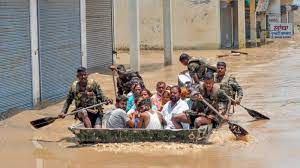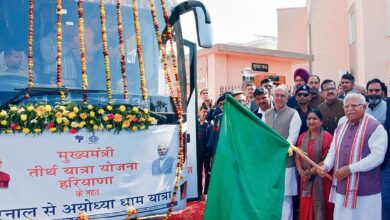Despite the severity of the north Indian floods, 12 states fight a rain shortage
However, 12 central, southern, and northeastern states like Telangana, Kerala, Karnataka, Bihar, and Jharkhand are still experiencing a deficient monsoon. This is due to a combination of western disturbances and monsoon westerlies that brought heavy rainfall over northern India in the past week, turning the region rain-surplus for this time of year.

All southern states, with the exception of Tamil Nadu, have gotten less rainfall than anticipated this monsoon season, according to statistics from the IMD (India Meteorological Department) for the period beginning on June 1. The mainland did not see significant rainfall during the first week of July’s heavy rains in the South; as a result, the planting of crops in Telangana, Andhra Pradesh, Karnataka, and portions of Kerala has been postponed. The administrations of Telangana and Karnataka have mentioned the possibility of a monsoon drought.
The total rainfall in the state from June 1, when the monsoon season is believed to have started, to July 11 was 150.4 mm, compared to the typical rainfall of 197.5 mm, with a divergence of -24%, according to a Telangana State Development and Planning Society (TSDPS) bulletin on Tuesday. The state had seen significant rainfall around this time previous year, totaling 395.6mm.
The report said that Telangana had seen a rainfall shortfall of -65% as compared to the previous year and that the monsoon, which began on June 24, had been unreliable. All 29 of the remaining districts got deficit rainfall, ranging from -5% (in Jangaon district) to -51% (in Khammam district), with the exception of Vikarabad, Sangareddy, Siddipet, and Narayanpet, which have so far reported slightly above average rainfall.
According to authorities, the majority of the main dams in Karnataka are almost empty, with water levels below 30 feet as opposed to a maximum of 124.8 feet, including the Krishnarajasagar (KRS) dam, a crucial water supply for Bengaluru and a provider of Cauvery water for drinking. In contrast, the water level was 106.5 feet higher last year.
In a similar vein, the Tungabhadra dam, which serves the Hyderabad and Karnataka areas, is presently only holding 4.1TMC of water, a marked decline from the 43.9TMC of previous year. According to the Karnataka State Natural Disaster Monitoring Cell, rainfall in the catchment regions that refill rivers like the Cauvery and the Tungabhadra in Karnataka has been less than one-third of average throughout the first 35 days of the monsoon season.
“Almost all zones are having gloomy weather, although they haven’t seen more than 12 cm of rain on average. A senior government official expressed concern: “This has placed reservoirs under significant stress and might damage electricity production and delivery of drinkable water if the situation does not improve.
Kerala, which has a 31% rain deficit, has had insufficient rainfall in several areas. According to a representative of the Kerala disaster management agency, “most other regions have received very little rainfall, with the exception of parts of northern Kerala.” He also mentioned the significant rainfall deficiency in 9 of the 14 districts. With a deficit of only 19%, Andhra Pradesh is in a better position than other southern states.
The IMD said that the effects of storm Biparjoy were the main reason why the monsoon in southern India had been poor from the start.
Because of a western disturbance and monsoon wind combination, the north saw severe rainfall. This has gone east and will soon deliver rain to Uttar Pradesh and Uttarakhand. With a depression forming in the Bay of Bengal, we anticipate the rains to return to southern India in a few days, according to IMD scientist Jenamani.
Although West Bengal has received a significant quantity of rain, the eastern provinces of Bihar (-33%), Jharkhand (-43%) and Odisha (-26% are also in deficit. Except for Assam, all northeastern states are rain-deficient despite having greater average rainfall than the rest of the nation. Any northeastern state experiences roughly twice as much rainfall on average than those on the Indian subcontinent. For instance, the 484 millimetres of rain that Arunachal Pradesh has gotten this monsoon season is 28% below average, while Rajasthan’s 249 millimetres of rain is 155% over average.







